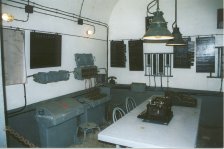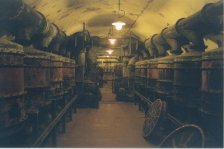The staircase descends for approximately 25-30 metres to the main gallery.

We take the 2.5T elevator (Monte-charge) access. The elevator is not available for us, so we walk down the stairs which wind around the elevator shaft. This is an example of an "Entreé en Puits", or, an entry with a well, or shaft, as opposed to an entry with an incline (entrée incliné) or one which goes straight back (entrée en plein pied).
The staircase descends for approximately 25-30 metres to the main gallery.

Between the bottom of the staircase and the area where the main gallery opens up into what is known as the "gare arrière", are 4 storage areas. These chambers, called the "Magasins aux Artifices", housed the fuses and detonators for the various shells. Curiously, the M1 main storage magazines (4) are located in the combat bloc area; 2 are adjacent to the M2 magazines and there is little distinction between them.
The tour takes you into the Galerie Principal (Main Gallery) and then sharply right into a smaller gallery which leads to the Men's Entrance, the caserne (living quarters) and the usine (power plant).

It is in the caserne where you can appreciate the restoration work done by the AALMA. Here you can visit the infimary, showers and bath, enlisted and officer's quarters, kitchen, food storage, wine cellar, and water storage tanks.

The gallery branches off at this point, leading to the Men's entrance on one side and the power station on the other. Halfway down the hall towards the power station is the 60cv railway sub station. Beyond that is an airlock.
Further down are oil and water storage tanks. The water cools the generators and the oil is used to fuel them. The machine room contains 4 Sulzer 160cv generators. Adjoining the generator room is the ventilation filter room. It is through these filters that any poison gas would be pumped, decontaminated, then re-distributed throughout the fort. Ventilation was critical to the survivability of the men, as evidenced by the rapid fall of fortress Liege due to the failure of the ventilation system.





